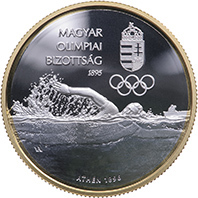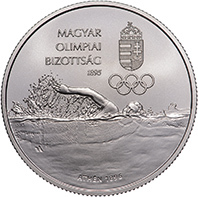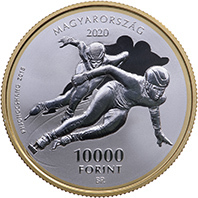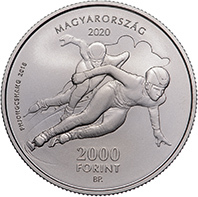2 December 2020
The Magyar Nemzeti Bank will issue a silver collector coin with a face value of 10,000 forints and its non-ferrous metal version of 2,000 forints to honour the 125th anniversary of the Hungarian Olympic Committee’s foundation. The special silver collector coin with a gold-coated edge and its non-ferrous metal version pay homage to the outstanding results in the history of Hungarian sport life and the first Hungarian gold medals at Summer and Winter Olympic Games. The coins named Magyar Olimpiai Bizottság (Hungarian Olympic Committee) were designed by applied artist Andrea Horváth.
Hungary participated actively in establishing the modern Olympic movement in 1894. Our country was represented by Ferenc Kemény. One year later, on 19 December 1895, the Hungarian Olympic Committee was the sixth of all the Olympic Committees to be set up. As a prominently public benefit body, the MOB controls and represents the Hungarian Olympic movement exclusively. It is tasked with preserving traditions, teaching the idea of Olympism, protecting the memories of our heroes for young generations. Hungarian athletes have won a total of 117 gold 151 silver and 174 bronze medals at modern Summer and Winter Olympic Games. Alfréd Hajós was the first Hungarian athlete to come out victorious for Hungary at the Olympics in 1896 in Athens, and the last so far was our short track speed skating relay team (Csaba Burján, Viktor Knoch, Liu Shaoang and Sándor Liu Shaolin) at the 2018 Winter Olympics. Incidentally, it was the first gold medal for Hungary at Winter Olympic Games.
The MNB will issue a silver collector coin of 10,000 forints and its non-ferrous metal version of 2,000 forints named ‘Magyar Olimpiai Bizottság' (Hungarian Olympic Committee) to mark the 125 years of the Hungarian Olympic Committee. The primary role of these collector coins is to offer education and recognise the success achieved by Hungarian athletes; therefore, they are not to be used in everyday payments. Their face value serves to preserve the value the coins represent to collectors.
The silver and the non-ferrous metal versions have the same design, with their denominations being the only difference. Another difference between the two coin types is that the edges of silver coins are decorated with a golden coating, which also supports the theme, and the non-ferrous metal coin has metallic colouring.
The collector coins were designed by applied artist Andrea Horváth.
The obverse of the Magyar Olimpiai Bizottság (Hungarian Olympic Committee) collector coins makes reference to the first gold medal won for Hungary at a Winter Olympic Games event, as the short track speed skating relay team wins the 5 km race at the 2018 Winter Olympics in Gangneung. The obverse recalls this result of significance in sports history and features a representation of four speed skaters while racing, two placed in the foreground and two represented as shadows in the background. To the left of the representation of the athletes, in a legend the lettering ‘PHJONGCSHANG 2018' is seen referring to the place and year of the first Hungarian win at Winter Olympics and the gold medal winner short track speed skating relay team. The compulsory design elements of collector coins are also placed on the obverse: the lettering ‘MAGYARORSZÁG' (Hungary) as the issuer, the ‘2020' mint year, the denominations ‘10 000' and ‘2 000 FORINT' and the ‘BP.' mint mark.
The obverse of the Magyar Olimpiai Bizottság (Hungarian Olympic Committee) collector coins
 Silver collector coin |
 Non-ferrous metal collector coin |
The thematic scheme on the reverse of the Magyar Olimpiai Bizottság collector coins focuses on the foundation of the sporting organisation of five rings and Hungary’s first victory at Olympic Games. The scene on the reverse of collector coins recalls the success achieved by Alfréd Hajós at the 1896 Summer Olympics as he wins the 100 and 1200 metre swimming events in rippling sea water of 11-13 degrees Celsius cold. On the reverse, there is a figure of a swimmer in the sea wearing a swimming suit from the 19th century, while two men are sitting in a watch-boat in the background. This whole scene is complemented with the lettering ‘ATHÉN 1896' (1896 Athens), which also lends its context.
Above the scene with the swimmer, on the left, in four lines, adjusted to the centre line of the coin the wording ‘MAGYAR OLIMPIAI BIZOTTSÁG' and the year ‘1895', when the MOB was founded, are placed. On the right of the letterings, the official logo of the Hungarian Olympic Committee is found.
The master mark of applied artist Horváth Andrea, the designer of the coin, is placed on the left below the swimmer, hidden in the representation of the sea.
The reverse of the Magyar Olimpiai Bizottság (Hungarian Olympic Committee) collector coins
 Silver collector coin |
 Non-ferrous metal collector coin |
Both collector coins are 38.61 mm in diameter. Their edge is reeded. The silver coin with a face value of HUF 10,000 is struck in .925 fine silver and weighs 31.46 grams. The non-ferrous metal coin with a face value of HUF 2,000 is produced from an alloy of copper (75%) and nickel (25%) and weighs 30.8 grams. 5,000 pieces can be made of the silver collector coin with a gold-coated edge in proof finish and 5,000 pieces of the non-ferrous version in BU finish.
In order to promote the commemorative and educational role of these collector coins as widely as possible, the silver collector coin ‘Magyar Olimpiai Bizottság’ will be available for purchase for three months, while stocks last, and the non-ferrous metal version for one year from the date of issuance, at face value, in the coin shop of Hungarian Mint Ltd., the producer and the distributor of the coins (Budapest, distr. V, 7 Báthory street) and in its webshop (https://www.penzvero.hu/) starting from 2 December 2020.